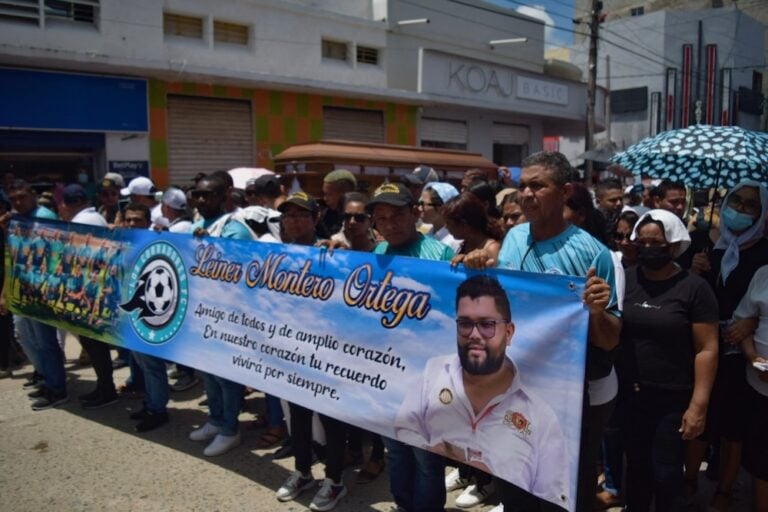(FLIP/IFEX) – The following is a FLIP press release: Analysis of Freedom of the Press in Colombia, January-April 2006 Summary: 42 press freedom violations in the first four months of 2006. Bucaramanga, Barrancabermeja and Bogotá are the cities with the highest incidence of violations. The electoral period and the coverage of topics related to the […]
(FLIP/IFEX) – The following is a FLIP press release:
Analysis of Freedom of the Press in Colombia, January-April 2006
Summary: 42 press freedom violations in the first four months of 2006. Bucaramanga, Barrancabermeja and Bogotá are the cities with the highest incidence of violations. The electoral period and the coverage of topics related to the paramilitaries are the principle factors.
The state of Freedom of the Press in Colombia, January-April 2006: A worrisome period
1. Statistics
There was a marked increase in the number of violations of press freedom in Colombia during the first four months of the year, compared to the same period in 2005. In total, the FLIP recorded 42 such violations in the first third of 2006; in 2005, there were 27.
Threats continued to constitute the most common form of violation. In this period, 27 threats were made against journalists; in 2005, 19 were recorded in the same period. Note that the number of threats recorded can exceed the number of victims, since a journalist may be threatened more than once.
Men continue to be the main targets of press freedom violations, at 74.3 %. Women were targets 25.64 % of the time.
The majority of violations are related to print media (21), followed by television (9) and radio (8). Finally, four violations targeted “freelance” reporters who were occasional collaborators with one or more media (these statistics do not account for the type of contractual link between the journalist and the media outlet).
It is notable that the incidence of violations against radio stations dropped in this period (only 8 in 2006, compared to 20 in 2005), while those against the print media increased (from 6 in 2005 to 21 in 2006).
Santander was the department with the highest number of violations, followed by Cundinamarca, where the violations all took place in Bogotá. Compared to 2005, the Norte de Santander saw a drop in the number of violations.
2. Commentary
– The electoral period was a factor behind the increase of press freedom violations in this period, especially in terms of threats. March – the month of the elections – registered the highest number of violations, at 18. Journalistic investigations into Congressional candidates or into topics relevant to party campaigns tended to provoke responses.
– All the violations in Santander took place in Bucaramanga (4) and Barrancabermeja (4). In seven of these cases, the threatened journalists had been investigating topics related to the paramilitaries in the zone. Indeed, there is evidence to suggest that paramilitary groups – active and demobilized alike – were the source of threats in other regions of the country as well.
– As has been the consistent trend in recent years, judicial actions with regard to threats to journalists – in 2005 and 2006 alike – did not produce satisfactory results. In the case of the murder of journalist Gustavo Rojas Gabalo, who died on 20 March 2005 after an attempt on his life on 4 February, the Attorney General’s Office only identified the individuals who carried out the crime.
– Authorities continue to threaten and obstruct the work of journalists. Eight violations of this kind were recorded in this period.
3. Recommendations
FLIP urges the authorities to take the following actions to protect and promote press freedom in Colombia:
– that the Attorney General, Mario Iguarán Arana, expedite investigations into the threats recorded in 2006 and 2005 that are still in process. By the same token, he should order the transfer of all cases relating to the threatening, assault, or killing of journalists to the Human Rights Department (Unidad de Derechos Humanos) in Bogotá, including the investigation into the murder of Gustavo Rojas Gabalo. Finally, he should investigate the re-organisation of new paramilitary groups and suspicions that they may be behind the new threats directed at journalists.
– that the High Commissioner for Peace, Luis Carlos Restrepo, demand of demobilised paramilitary groups, and those in the process of demobilising, that they respect press freedom and other fundamental rights of journalists, and that – in coordination with the Attorney General’s Office – he act to determine which of these groups is behind the numerous threats against journalists in Santander and other parts of the country.
– that the Vice-President of the country, Francisco Santos, speed up the initiation of the inter-institutional committee to be formed by the Attorney General’s Office and the Judicial Police Office (Dirección de Policía Judicial), as indicated in a February 2006 meeting.
– that the Public Prosecutor, Edgardo Maya Villazón, investigate those government officials who are accused of having threatened journalists or who have otherwise obstructed their work.
– that the Interior and Justice Minister, the Administrative Security Department (Departamento Administrativo de Seguridad, DAS), and the police all continue to protect journalists throughout the country.
– that journalists denounce all violations of press freedom.
To see the full report, see: http://flip.org.co/informes/2006/Informe%20enero%20-%20abril%20de%202006.doc


